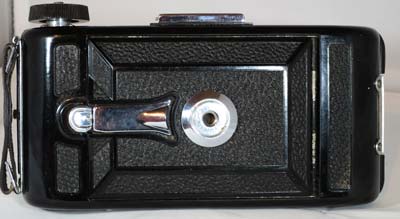Kershaw Soho Raven
Specification

| Manufacturer | : | Kershaw Soho (Sales) Ltd |
|---|---|---|
| Produced | : | 1947 |
| Classification | : | Medium Format |
| Body Type | : | Folding Bed |
| Bellows Deployment | : | Self Erecting |
| Construction | : | Bakelite |
| Film Type | : | 120 |
| Film Width | : | 62mm |
| ImageSize | : | 2¼ x 3¼ in |
| No. of Images | : | 8 |
| Lens Type | : | Triplet |
| Focal Length | : | 4" (100mm) |
| Focus Type | : | Variable |
| Focal Range | : | 6ft - inf. |
| Aperture Type | : | Variable Iris |
| Aperture | : | f6.3 - f/22 |
| Shutter Type | : | Everset |
| Shutter Speeds | : | T,B, I(1/25, 1/50, 1/100 s) |
| Size Open (w x h x d) | : | 95 x 180 x 142 mm |
| Size Closed (w x h x d) | : | 95 x 180 x 53 mm |
| Weight | : | 711g |
Art Deco Credentials
![]()
![]()
![]()
Noteworthy: Worth giving special attention
- Produced after the main Art Deco period.
- Moulded Bakelite body.
- Leather patterning on Bakelite.
- Distinctive oblong shaped pattern on folding bed.
- Star motif embossed in Bakelite on rear.
- Ornate chrome struts
- Chrome back closing lock.
- Chrome table stand and door lock.
- Chrome bezel around pop-up finder
- Chrome bezel around red window.
- Chrome tripod mounts
Description
The Kershaw Raven is a black Bakelite folding bed camera for type No. 120 rollfilm. It is a handsome and heavy camera. It was made in England by Kershaw Soho (Sales) Ltd. in about 1947. The Bakelite front door unfolds as the bed for the lens standard and is reinforced with a metal plate to mount the folding struts. When unfolded the lens standard position is fixed. The door carries a tripod bush and a folding table stand with a second tripod bush for landscape pictures mounted in the side of the body. The door carries a distinctive oblong shaped pattern and the rear of the camera features a star embossed into the Bakelite.

The Raven has a 4-inch (100mm) f/6.3 Kershaw Anastigmat triplet lens. A dial-set everset shutter gives speeds of 1/25, 1/50 and 1/100 second, plus 'T' and 'B'. It has a cable release socket. The aperture stops from f/6.3 to f/22. There are both a brilliant finder and a collapsible frame finder. Focussing is via a rotating front-element giving a range from 6ft to infinity. Frame advance is by red window which is square shaped and is not linked to the shutter.

How to Use
Find the manual for this camera here:- Kershaw Raven Manual
This camera takes 120 film which is easily available. It supports Timed mode and Instant with a speeds from 1/25 to 1/100 sec. It has a aperture settings from f/6.3 to f/22. With slow shutter speeds of only 1/25 or 1/50 sec, make sure you brace the camera against your body or use a tripod and press the shutter smoothly to avoid camera shake.
If you don't want to bother with an exposure meter, follow the guide shown. The shutter speeds are 1/25s, 1/50s and 1/100s. It is based on the 'Sunny 16' rule. Film is so forgiving and will produce acceptable results even when overexposed by 2 or 3 stops or underexposed by 1 stop.
Remember that the exposure guide in the camera user manual may not be helpful as it is based on the use of old film with a low ISO value.
The tables assume that the sun is at least 30 degrees above the horizon - that's 10am - 5pm on a summer's day (May-August) in the UK.
If you are not sure about the light level, err on the side of overexposure - i.e. assume the smaller f number.
Where there is a choice, a larger f number will give a larger depth of field.
Using ISO 100/125 film
| Weather Conditions | Shadow Detail | Shutter Speed (s) | ||
|---|---|---|---|---|
| 1/25 | 1/50 | 1/100 | ||
 Sunny SunnySnow/Sand | Dark with sharp edges | - | - | f/22 |
 Sunny Sunny | Distinct | - | f/22 | f/16 |
 Slight Overcast Slight Overcast | Soft around edges | f/22 | f/16 | f/11 |
 Overcast Overcast | Barely visible | f/16 | f/11 | f/8 |
 Heavy Overcast Heavy Overcast | None | f/11 | f/8 | f/6.3 |
 Open Shade Open Shade/Sunset | None | f/8 | f/6.3 | - |